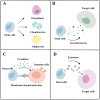Cell-Based Therapies for Degenerative Musculoskeletal Diseases
- PMID: 37199688
- PMCID: PMC10375105
- DOI: 10.1002/advs.202207050
Cell-Based Therapies for Degenerative Musculoskeletal Diseases
Abstract
Degenerative musculoskeletal diseases (DMDs), including osteoporosis, osteoarthritis, degenerative disc disease, and sarcopenia, present major challenges in the aging population. Patients with DMDs present with pain, functional decline, and reduced exercise tolerance, which result in long-term or permanent deficits in their ability to perform daily activities. Current strategies for dealing with this cluster of diseases focus on relieving pain, but they have a limited capacity to repair function or regenerate tissue. Cell-based therapies have attracted considerable attention in recent years owing to their unique mechanisms of action and remarkable effects on regeneration. In this review, current experimental attempts to use cell-based therapies for DMDs are highlighted, and the modes of action of different cell types and their derivatives, such as exosomes, are generalized. In addition, the latest findings from state-of-the-art clinical trials are reviewed, approaches to improve the efficiency of cell-based therapies are summarized, and unresolved questions and potential future research directions for the translation of cell-based therapies are identified.
Keywords: cell-based therapies; degenerative musculoskeletal diseases; exosomes; extracellular vesicles; stem cells.
© 2023 The Authors. Advanced Science published by Wiley-VCH GmbH.
Conflict of interest statement
The authors declare no conflict of interest.
Figures



Similar articles
-
Insights into the underlying pathogenesis and therapeutic potential of endoplasmic reticulum stress in degenerative musculoskeletal diseases.Mil Med Res. 2023 Nov 9;10(1):54. doi: 10.1186/s40779-023-00485-5. Mil Med Res. 2023. PMID: 37941072 Free PMC article. Review.
-
Insights into the Notch signaling pathway in degenerative musculoskeletal disorders: Mechanisms and perspectives.Biomed Pharmacother. 2023 Dec 31;169:115884. doi: 10.1016/j.biopha.2023.115884. Epub 2023 Nov 17. Biomed Pharmacother. 2023. PMID: 37981460 Review.
-
Harnessing Stem Cell-Derived Extracellular Vesicles for the Regeneration of Degenerative Bone Conditions.Int J Nanomedicine. 2023 Sep 29;18:5561-5578. doi: 10.2147/IJN.S424731. eCollection 2023. Int J Nanomedicine. 2023. PMID: 37795043 Free PMC article. Review.
-
Therapeutic application of extracellular vesicles for musculoskeletal repair & regeneration.Connect Tissue Res. 2021 Jan;62(1):99-114. doi: 10.1080/03008207.2020.1781102. Epub 2020 Jun 30. Connect Tissue Res. 2021. PMID: 32602385 Review.
-
Stem cells in degenerative orthopaedic pathologies: effects of aging on therapeutic potential.Knee Surg Sports Traumatol Arthrosc. 2017 Feb;25(2):626-636. doi: 10.1007/s00167-015-3763-9. Epub 2015 Aug 23. Knee Surg Sports Traumatol Arthrosc. 2017. PMID: 26298714 Review.
Cited by
-
Composition, functions, and applications of exosomal membrane proteins.Front Immunol. 2024 Aug 1;15:1408415. doi: 10.3389/fimmu.2024.1408415. eCollection 2024. Front Immunol. 2024. PMID: 39148736 Free PMC article. Review.
-
The impact of acute and chronic aerobic and resistance exercise on stem cell mobilization: A review of effects in healthy and diseased individuals across different age groups.Regen Ther. 2024 May 7;27:464-481. doi: 10.1016/j.reth.2024.04.013. eCollection 2024 Dec. Regen Ther. 2024. PMID: 38745840 Free PMC article.
-
Evaluation of cognitive and mobility function in geriatric dogs following treatment with stem cell and stem cell extracellular vesicles derived from embryonic stem cells: a pilot study.Front Vet Sci. 2025 Mar 26;12:1549870. doi: 10.3389/fvets.2025.1549870. eCollection 2025. Front Vet Sci. 2025. PMID: 40206251 Free PMC article.
-
Histone deacetylase inhibition enhances extracellular vesicles from muscle to promote osteogenesis via miR-873-3p.Signal Transduct Target Ther. 2024 Sep 30;9(1):256. doi: 10.1038/s41392-024-01976-0. Signal Transduct Target Ther. 2024. PMID: 39343927 Free PMC article.
-
PMAIP1 regulates autophagy in osteoblasts via the AMPK/mTOR pathway in osteoporosis.Hum Cell. 2024 Jul;37(4):1024-1038. doi: 10.1007/s13577-024-01067-w. Epub 2024 Apr 30. Hum Cell. 2024. PMID: 38691334
References
Publication types
MeSH terms
Grants and funding
- 81972102/National Natural Science Foundation of China
- 82002330/National Natural Science Foundation of China
- 81972115/National Natural Science Foundation of China
- 2019YFC0840705/National Key Research and Development Program of China
- 2020-JCJQ-QT-033/Young Elite Scientist Sponsorship Program by the China Association for Science and Technology
LinkOut - more resources
Full Text Sources
Medical
